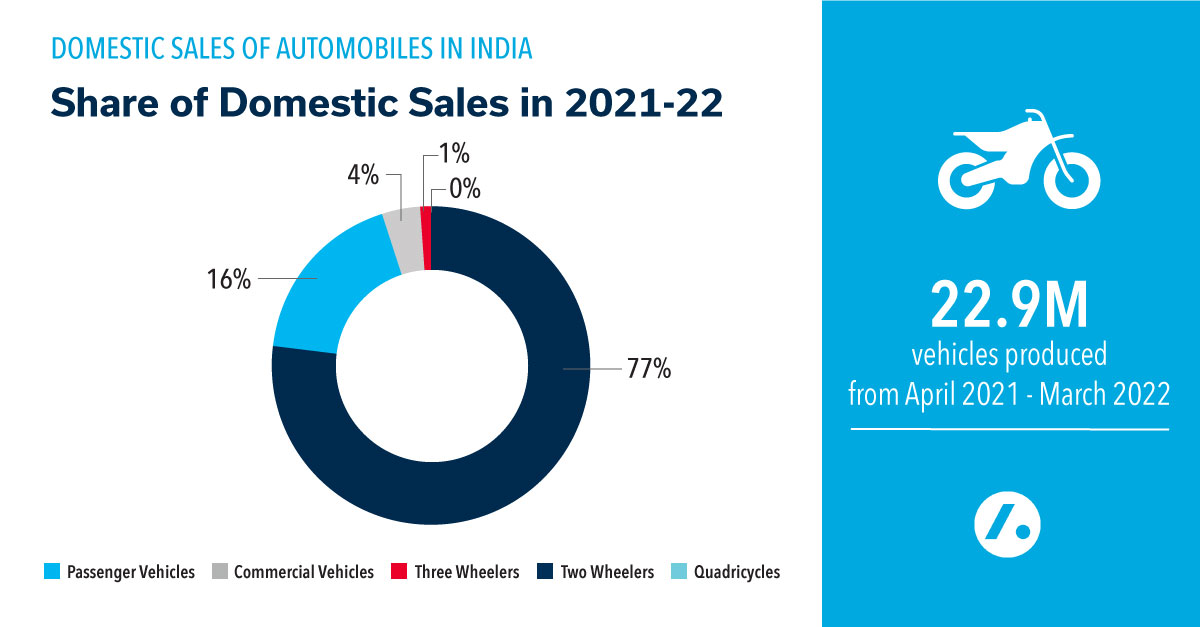
Outlook of Automobile Industry in India: 2023
The Indian automobile industry is one of the country’s largest and most dynamic industries. It encompasses a wide range of vehicles—including passenger cars, commercial vehicles, two-wheelers, and three-wheelers. The auto industry accounts for 49 percent of India’s manufacturing gross domestic product (GDP) and 7.1 percent of its overall GDP.
Snapshot
The Indian auto market was ranked the third largest globally as it overtook Japan in 2022 and the fourth largest manufacturer of commercial vehicles in 2023. It is projected to increase by 7 to 10 percent in the next fiscal year.
Vroom Vroom
The domestic demand for automobiles in India has been steadily increasing. Factors such as a growing middle class, increasing disposable income, improved road infrastructure, and easy access to finance have fueled the demand for vehicles. ICRA, an independent investment information and credit rating agency, reports that in the fiscal year 2024, industry growth will be:
- Passenger: 6-9%
- Commercial: 7-10%
- Two-wheelers (tractors): 6-9%
- Three-wheelers (motorcycles, mopheads, and scooters): 4-6%
“We expect growth across automotive industry segments to remain at high single-digit levels in FY2024. While the passenger vehicle, commercial vehicle, and tractor segment volumes would continue to trend upwards, aided by favourable demand drivers, the two-wheeler industry is also expected to record moderate growth in volumes aided by a low base,” said Shamsher Dewan, Senior Vice President at ICRA. Additionally, the 2023-24 Union Budget focuses on India’s transition to sustainable transportation alternatives spiking a growing interest of automotive companies.
As a prominent auto exporter, India’s automobile exports grew 15 percent in the fiscal year 2023. This figure will likely grow at a CAGR of 3.04 percent from 2023 to 2027.
 In the next decade, the electronic vehicle (EV) is slated to take center stage. The Economic Times reported that by 2030, 80 percent of two and three-wheelers, 40 percent of buses, and 30 to 70 percent of cars in India will be EVs, including all government-owned vehicles. Put simply, the automotive industry is charged and ready to roll in India.
In the next decade, the electronic vehicle (EV) is slated to take center stage. The Economic Times reported that by 2030, 80 percent of two and three-wheelers, 40 percent of buses, and 30 to 70 percent of cars in India will be EVs, including all government-owned vehicles. Put simply, the automotive industry is charged and ready to roll in India.
The road ahead
India has a large pool of skilled professionals in engineering, design, manufacturing, and other relevant areas at relatively lower labor costs than developed countries—giving the Indian automobile industry a competitive advantage. As a result, the automotive sector provides excellent opportunities for people in the labor force.
The automotive industry in India supports over eight million jobs and up to 30 million more in the value chain. The sector will play a vital role in the green energy transition. Electronic vehicles will create 50 million direct and indirect jobs by 2030, and opportunities are expected to increase by 40-45 percent in the coming months. India’s demand for decoding talent is led by automotive (30 percent), followed by manufacturing (25 percent) and banking, financial services, and insurance (BFSI, 24 percent).
Related: IoT Interview Questions, Part One: Manufacturing, Automotive, Retail
Over the past 60 years, Acara has filled thousands of positions within the automotive industry. Our recruitment teams are well-versed in finding qualified candidates to handle the requirements of these positions—including design, engineering, information technology, and research and development. Contact us today to learn more about how we can work together to streamline your talent acquisition needs and build the automotive workforce you need to grow and innovate.
This blog was written by Acara Vice President of Operations Nagarajan C.






